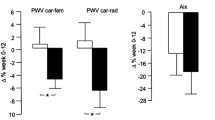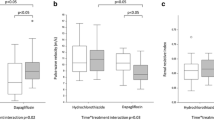Summary
The effects of ketanserin (40 mg p.o.) on blood pressure and brachial haemodynamics (brachial artery diameter, brachial blood velocity and blood flow) have been compared in a double-blind study with those of ritanserin (10 mg p.o.) and placebo. Haemodynamic parameters were measured before and 1 h after treatment. Patients with mild to moderate essential hypertension participated in this study, 6 each on ketanserin, ritanserin and placebo.
Placebo significantly reduced heart rate and did not modify the other parameters. Compared to placebo, ketanserin significantly reduced systolic and diastolic blood pressure, increased brachial blood velocity and flow, and decreased forearm vascular resistance.
Compared to placebo, ritanserin slightly decreased blood pressure and slightly increased blood flow, but neither effect was significant.
When blood circulation to the hand was excluded, neither ketanserin nor ritanserin modified the proximal arterial resistance or blood flow.
It is concluded that the actions of ketanserin and ritanserin essentially occurred in the distal part of the upper limb, and alpha1-receptor blockade is probably involved.
Similar content being viewed by others
References
Leysen JE, Awouters F, Kennis L, Laduron PM, Vandenberg J, Janssen PAJ (1981) Receptor binding profile of R41468, a novel antagonist at 5-HT2 receptors, Life Sci 28: 1015–1021
Peroutka SJ, Sneyder SH (1979) Multiple serotonin receptors: Differential bindings of (3H)-5-hydroxyltryptamine, (3H)-lyseric acid diethylamide and (3H)-spyroperidol. Mol Pharmacol 16: 687–699
Cohen ML, Fuller RM, Wiley KS (1981) Evidence for 5-HT2 receptors mediating contraction in vascular smooth smuscle. J Pharmacol Exp Ther 218: 421–428
Van Neuten JM, Jansen PAT, Ridder W de, Van Houtte PM (1982) Interaction between 5-hydroxytryptamine and other vasoconstrictor substances in the isolated femoral artery of the rabbit. Effect of ketanserin (R 41468). Eur J Pharmacol 7: 281–284
Hedner T, Persson B, Berglund GK (1983) Ketanserin, a novel 5-hydroxytryptamine antagonist monotherapy in essential hypertension. Br J Clin Pharmacol 16: 121
Wenting GJ, Woittiez AJJ, Man In't Veld AJ, Schalekamp MADH (1984) 5HT, alpha-adrenoreceptors and blood pressure. Effects of Ketanserin in essential hypertension and autonomic insufficiency. Hypertension 6: 100–118
Ball SG, Zabludowsky JR, Robertson JIS (1983) Mechanism of antihypertensive action of Ketanserin in man. Br Med J 287: 1065
Ferrara LA, Fasana ML, Soro S, Rubba P, Ianuzzi A (1985) Cardiovascular effects of Ketanserin, a new antiserotonergic agent in the treatment of arterial hypertension. J Clin Pharmacol 25: 187–192
Murphy BF, Whitworth JA, Kincaid-Smith P (1985) Ketanserin in the acute management of severe hypertension. J Cardiovasc Pharmacol [Suppl 7]: S168-S171
Reiman IW, Fröhlich JC (1983) Mechanism of antihypertensive action of ketanserin in man. Br Med J 287: 381–383
Casiglia E, Gava R, Semplicini A, Nicolin A, Pessina AC (1986) The mechanism of anti-hypertensive effects of ketanserin: a comparison with metoprolol. Br J Clin Pharmacol 22: 751
Wenting GJ, Man in't Veld AJ, Woittiez AJ, Boomsma F, Schalekamp MADH (1982) Treatment of hypertension with ketanserin, a new selective 5-HT2 receptor antagonist. Br J Med 284: 537–539
Van Nueten JM, Xhonneux R, Janssens WJ, Schnuurkes JAJ, Janssen PAJ (1986) Interaction between S2-serotoninergic and alpha-1-adrenergic receptors and control of blood pressure. Blood vessels 23: 104
Conolan S, Quinn MJ, Taylor DA (1986) In vivo and in vitro activity of selective 5-hydroxytryptamine 2 receptor antagonists. Br J Pharmacol 89: 129–135
Levenson JA, Peronneau PP, Simon Ach, Safar ME (1981) Pulsed Doppler: Diameter, velocity and flow of the brachial artery in sustained essential hypertension. Cardiovasc Res 15: 164–170
Levenson J, Simon A, Pithois-Merli I (1987) Brachial arterial changes in response to wrist occlusion in normotensive and hypertensive men. Am J Physiol 253: H217-H224
Simon Ach, Chau NP, Levenson JA (1988) Brachial artery hemodynamic response to acute converting enzyme inhibition by enalaprilat in essential hypertension. Clin Pharmacol Ther 43: 49–54
Simon ACh, Levenson J, Bouthier J, Safar M, Avolio P (1985) Evidence of early degenerative changes in large arteries in human essential hypertension. Hypertension 7: 675–680
Zar JH (1984) Biostatistical analysis. Prentice Hall, New Jersey, pp 130–131
Chau NP, Tarazi RC, Fouad FM, Birkenhager WH, Leeuw PE de (1982) Index for normalization of blood volume. Clin Sci 63: 375s-377s
Rosenthal J, Koehle W, Gruebel B, Fischer R (1986) Moderate essential hypertension control: a double-blind cross-over study between a serotonin antagonist and a post-synaptic alpha-blocker. J Hypertens 4 [Suppl 1]: S85-S87
Hosie J, Stott DJ, Robertson JIS, Ball SG (1987) Does acute serotonergic type-2 antagonism reduce blood pressure? Comparative effects of single doses of ritanserin and ketanserin in essential hypertension. J Cardiovasc Pharmacol 10 [Suppl 3]: S86-S87
Idzikwski C, Mills FJ (1986) 5-HT2 antagonist causes sustained increase in human slow wave sleep. Clin Sci 70 [Suppl 13]: 89–93
Stott DJ, Saniabadi AR, Hosie J, Lowe GDO, Ball SG (1988) The effects of the 5HT2 antagonist ritanserin on blood pressure and serotonin-induced platelet aggregation in patients with untreated essential hypertension. Eur J Clin Pharmacol 35: 123–129
Vanhoutte P, Amery Z, Birkenhäger W, Breckenbridge A, Bühler F, Distler A, Dormandy J, Doyle A, Frohlich E, Hansson L, Hedner T, Hollenberg N, Jensen HE, Lund-Johansen PL, Meyer Ph, Opie L, Robertson I, Safar M, Schalekamp M, Symoens J, Jensen JT, Zanchetti A (1988) Serotonic mechanisms in hypertension. Focus on the effects of ketanserin. HYpertension 11: 111–133
Blauw GJ, Brummelen PV, Chang PC, Vermeij P, Zieten PA van (1988) Regional vascular effects of serotonin and ketanserin in young, healthy subjects. Hypertension 11: 256–263
Author information
Authors and Affiliations
Rights and permissions
About this article
Cite this article
Chau, N.P., Pithois-Merli, I., Levenson, J. et al. Comparative haemodynamic effects of ketanserin and ritanserin in the proximal and distal upper limb circulations of hypertensive patients. Eur J Clin Pharmacol 37, 215–220 (1989). https://doi.org/10.1007/BF00679772
Received:
Accepted:
Issue Date:
DOI: https://doi.org/10.1007/BF00679772




